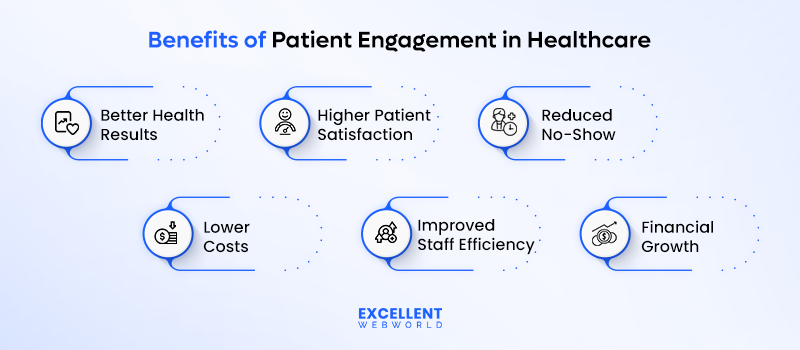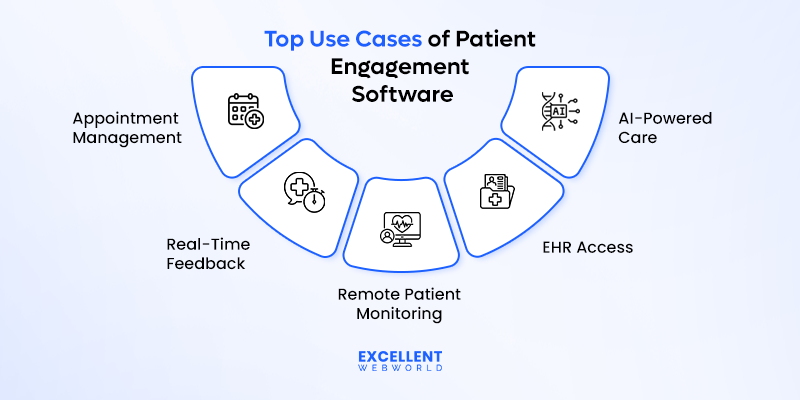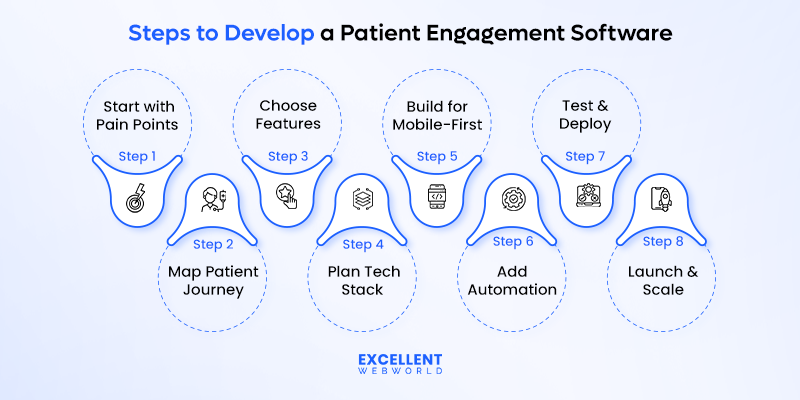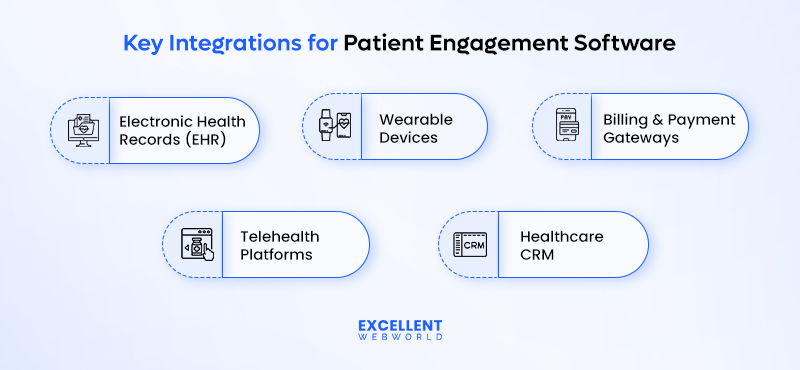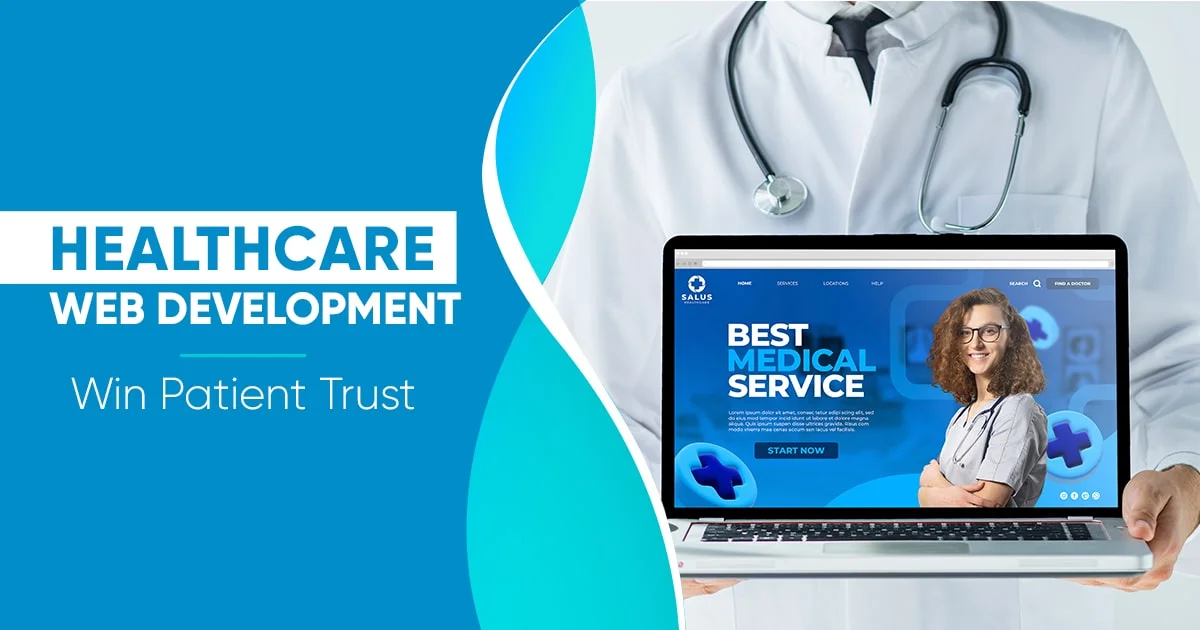Are you tired of patients “canceling” or “ghosting” appointments?
Are you frustrated watching staff drown in repetitive calls while competitors win patients with better digital experiences?
Then, you’re living every hospital COO’s nightmare.
The global patient engagement software market is expected to reach $58 billion by 2035. (Source: Root Analysis). Smart healthcare leaders are already capitalizing on this boom.
Here’s the thing: jumping into patient engagement software development without a clear strategy is like performing surgery without a plan. You need experienced guidance to succeed.
This blog is your answer. We’ve created this guide using over 13+ years of healthcare app development experience and insights from more than 900 successful projects.
By the end, you’ll have your complete roadmap. You’ll know which features drive patient engagement, how to integrate with your existing systems, and what implementation steps guarantee success without disrupting your operations.
What is Patient Engagement Software? Why Patient Engagement Matters?
Patient engagement software refers to virtual tools that help you connect with patients throughout their care journey. These encompass appointment scheduling, patient reminders, and access to clinical records.
Your patient engagement solutions create communication channels through messaging and video visits. They work alongside your existing systems without replacing them.
Why Patient Engagement Matters?
What is the Cost of Not Having Patient Engagement Technology in Place?
Here’s what you’re losing without proper patient engagement:
Note: The cost of doing nothing is higher than investing in the right technology. Partner with a healthcare app development company like ours, which assists you in creating data-driven patient engagement software that lets you avoid those losses and win back your loyal clients.
What are the Benefits of Patient Engagement in Healthcare?
Patient engagement in healthcare gives numerous benefits, including improved health outcomes, improved patient satisfaction, and reduced healthcare costs.
Let’s break down the key benefits in detail.
Better Health Results
When patients stay engaged, they tend to comply with their treatment plans more successfully. They take their medication on time and attend appointments. This way, there are fewer headaches and quicker recovery times.
Your hospital sees better patient outcomes. Patients trust you more when they are not worried about their care.
Higher Patient Satisfaction
Engaged patients feel heard and valued. They rate your hospital higher on satisfaction surveys. Happy patients tell their friends about your services.
A patient engagement solution helps you connect with patients regularly. This builds stronger relationships between your staff and patients.
Reduced No-Show
Automated patient reminders extensively lessen the number of overlooked appointments. Patients obtain text messages or calls earlier than their scheduled visits.
This saves your staff time and increases revenue. You stop losing money from empty appointment slots. Your schedule runs smoother with fewer gaps.
Lower Administrative Costs
A HIPAA-compliant patient software automates daily tasks. Your workforce spends much less time on phone calls and paperwork. They focus on patient care instead.
Patient portal solutions enable patients to book appointments and view their results online. This reduces the number of calls to your front desk.
Improved Staff Efficiency
Your nurses and administrative team members feel less overwhelmed. Patients can handle fewer repetitive tasks after using digital tools. This ends in higher satisfaction and lower turnover.
Working with a telemedicine app development company can streamline virtual consultations, making them efficient. This reduces journey time for patients and increases appointment availability.
Better Financial Performance
Engaged patients generally tend to pay their bills more promptly and return for follow-up care. You see expanded revenue from improved patient retention.
Additionally, you frequently invest in custom software development services to create software that precisely meets your hospital’s specific needs.
These tailor-made software solutions streamline operations and reduce manual work, resulting in lower operational expenses that improve your bottom line.
What are the Top Use Cases of Patient Engagement Across the Healthcare Industry?
Patient engagement isn’t always just about keeping patients happy; it is about building systems that work for both your staff and your patients.
Here are the most impactful ways hospitals are using engagement tools to get rid of operational challenges:
Automated Appointment Management
Appointment scheduling software eliminates the back-and-forth phone calls that consume your staff’s time and resources. Patients can book, reschedule, or cancel appointments online at any time.
Your front desk team stops playing phone tag. Patients receive immediate affirmation and automatic reminders, which reduce no-shows by up to 40%.
Real-Time Patient Feedback
A real-time patient feedback system captures satisfaction ratings immediately after visits. You spot problems before they become a significant issue or a negative opinion.
Instead of waiting for quarterly surveys, you receive immediate alerts as patient share their experiences with poor quality. This allows you to resolve issues speedily and prevent patients from switching to the competition.
Remote Patient Monitoring
Virtual health engagement tools extend your care beyond workplace visits. Patients can monitor their signs and symptoms, access test results, and receive follow-up care instructions from the comfort of their own homes.
This reduces unnecessary visits while maintaining patients linked to your care team. Your staff can focus on high-priority cases rather than routine check-ins.
Streamlined Health Records Access
EHR system development with patient portals enables health records to be accessed at any time and from any location. Patients can view lab results, medication lists, and care plans without needing to call your office.
Your nurses stop answering the same questions about test results. Patients feel more informed and engaged in their care selections.
AI-Powered Care Coordination
AI in healthcare statistics indicates that patient information can be used to predict who is likely to require follow-up care or is at risk of missing appointments. The system sends customized reminders and health recommendations to users.
Your patient engagement software solutions work smarter, not harder. Patients get the right message at the right time without overwhelming your staff.
What are the Must-Have Features of Patient Experience Software?
You need software that works for your patients and your admin staff. The right features can flip pissed-off patients into loyal ones while making your team’s job easier.
| Feature | Description |
|---|---|
| Multi-Channel Communication Hub | An effective patient engagement system handles all patient messages through text, email, and app notifications. |
| Self-Service Portal | Patients can access health information, download forms, and update details without needing to call your office through EHR integration. |
| Automated Reminder Engine | Smart notifications send appointment reminders, medication alerts, and health screenings using patient retention software features. |
| Video Consultation Platform | Built-in video calling enables patients to connect with doctors from anywhere through telehealth engagement software. |
| Instant Feedback Collector | Quick surveys and scoring systems capture patient satisfaction immediately after visits. |
| Predictive Analytics Dashboard | AI-powered insights predict appointment no-shows and care needs. |
| Digital Check-In System | Patients complete registration and forms on tablets or phones before their appointments. |
| Waitlist Management | Automatic notifications when earlier appointment slots become available. |
| Payment Processing | Secure online payment portal for bills, co-pays, and outstanding balances. |
| Prescription Refill Requests | Patients can request medicine refills digitally, eliminating the need for phone calls. |
| Lab Results Delivery | Secure delivery of test results with explanations directly to patient accounts. |
| Care Plan Tracking | Visual progress charts showing treatment milestones and next steps. |
| Language Translation | Real-time translation for non-English speaking patients. |
| Symptom Checker | The AI-powered tool enables patients to identify symptoms earlier, eliminating the need for scheduling appointments. |
| Insurance Verification | Automatic insurance coverage checks and pre-authorization requests. |
| Chronic Disease Monitoring | Daily check-ins and symptom tracking for ongoing conditions. |
| Telehealth Waiting Room | The virtual waiting area provides estimated wait times and updates from providers. |
Note: A healthcare-focused AI development company like ours can transform your medical operations by seamlessly integrating advanced AI-led features with existing systems, thereby enhancing patient care and operational efficiency.
How to Develop a Patient Engagement Software?
Building patient engagement software should not be overwhelming. You can create a system that works together with your existing setup and connects with your patients.
Here’s how to get started with it:
Step 1: Start with Your Biggest Pain Points
Examine at which stage your patients tend to drop off the most. Have they missed appointments? Poor follow-ups? Low portal usage?
Pick one problem that you can solve. Considering the benefits of custom software development can help you create a tailored solution that directly addresses that specific challenge, rather than trying to repair the whole lot at once.
Step 2: Map Out Your Current Patient Journey
Walk through the process that occurs when a patient visits your health facility. From booking to follow-up care. Identify the areas in which patients become annoyed or stressed.
These spots are where your patient engagement systems can make the most significant difference.
Step 3: Choose Your Core Features
Your software should resolve real problems, not create new ones. Focus on functions that reduce work for your staff while also supporting patient care.
Essential features include:
Step 4: Plan Your Technology Stack
You don’t need to rebuild everything from scratch. Your software development process should integrate seamlessly with your existing systems.
Look for cloud-based solutions that can easily integrate with your current EHR. It saves time and decreases costs while keeping your records secure.
Step 5: Build for Mobile First
Your patients live on their smartphones. Ensure your software runs flawlessly on mobile devices. Simple, clean interfaces lead to greater patient adoption than complex systems. Think of apps your patients already love and use.
Step 6: Add Smart Automation
Clinical workflow automation reduces the need for repetitive manual work. Set up automated reminders, follow-up messages, and appointment confirmations to ensure timely communication.
A good remote patient monitoring software can track patient progress between visits. This keeps patients engaged while giving your staff valuable data.
Step 7: Test with Real Patients
Before launching, test your software with actual patients. Observe how they use it and where they come upon difficulties. Make modifications primarily based on their feedback. This ensures that your final product will be robust and user-friendly.
Step 8: Start Small and Scale Up
Launch with one department or patient group at a time. Learn what works and fix what does not. Once you achieve extraordinary outcomes, expand to other areas of your routine. This method reduces risk and builds self-belief in your investment.
What are the Key Integrations for Patient Engagement Software Development?
Key integrations for patient engagement software development include:
Electronic Health Records (EHR)
Your EHR holds all the information about the patient. When correctly linked, patients can view their test results immediately and book appointments based on their clinical information.
Telehealth Platforms
Your engagement software must have video calling tools. Patients get appointment reminders with direct video links. This keeps you ahead of telehealth trends while reducing the number of virtual visits that go ignored.
Wearable Devices
Fitness trackers send real-time records to your gadget. You can assess the patient’s progress during visits and identify problems early.
Billing and Payment Gateways
Connected payment systems send clear cost breakdowns before appointments. Patients can easily pay online, thereby reducing their wait time for collection.
Healthcare CRM Systems
Your healthcare IT platforms must communicate effectively with one another. CRM integration tracks every interaction of the patient and helps you to map their journey.
What are the Key Considerations to Keep in Mind while Integrating Patient Engagement Software?
Integration Capabilities
Verify that your new software is compatible with your current system. Request demos that showcase real facts and transferable skills.
Security and Compliance
Look for HIPAA-compliant applications with end-to-end encryption. Regular security audits should be standard.
User Experience
If patients can’t use it efficiently, they won’t use it at all. Test the interface with actual patients before making a purchase.
Functionality and Features
Focus on the patient satisfaction tools that address your most significant issues first. Automated appointment reminders and quick invoice pay make the most effect.
Scalability and Customization
Your patient base will grow. Your software should grow with you without requiring a complete rebuild.
What are the Best Patient Engagement Technologies for 2025?
Here is the ideal tech stack for your patient engagement software:
| Category | Related Technology |
|---|---|
| AI & Machine Learning | ChatGPT API, Google Dialogflow, Microsoft Bot Framework, Amazon Lex, IBM Watson Assistant |
| Mobile | React Native, Flutter, Swift (iOS), Kotlin (Android) |
| Cloud | AWS, Microsoft Azure, Google Cloud, IBM Cloud, Oracle Cloud |
| Communication Tools | Twilio, SendGrid, Mailchimp, Slack API, WhatsApp Business API |
| Data Analytics | Google Analytics, Tableau, Power BI, Mixpanel, Amplitude |
| Integration APIs | HL7 FHIR, Epic MyChart, Cerner, Allscripts, athenahealth |
| Security & Compliance | HIPAA frameworks, OAuth 2.0, SSL/TLS encryption, Microsoft Intune, Okta |
| User Experience | Figma, Adobe XD, Sketch, InVision, Hotjar |
How Much Does it Cost to Develop a Patient Engagement Software?
The cost to develop patient engagement software starts from $30,000 for a basic option to $300,000 or more for a more advanced, fully integrated system.
The final budget will depend on your precise needs, desired features, and compliance requirements.
Here’s an in-depth breakdown of patient engagement software development costs as per the complexity of the app:
| Complexity of App | Estimated Cost (USD) | Timeline | Key Features |
|---|---|---|---|
| Basic | $30,000–$60,000 | 2–3 months | Appointment scheduling, reminders, secure messaging, basic patient records |
| Moderate | $60,000–$160,000 | 3–6 months | EHR integration, prescription requests, patient feedback, analytics, chatbots |
| Advanced | $160,000–$300,000+ | 6–10+ months | Telemedicine, remote monitoring, AI/IoT integration, advanced analytics, full customization, multi-platform support |
Which Factors Affect Patient Engagement Software Cost?
What is the Best Patient Engagement Software of 2025?
Here are the top patient engagement platforms that hospital COOs trust to solve real problems.
1. NexHealth
NexHealth makes scheduling simple. Your patients can book online while your staff handles more critical tasks. It connects with your EHR system, ensuring that no information is lost.
2. TeleVox
TeleVox helps you reach patients before they forget appointments. Their automated messages reduce no-shows and improve your HCAHPS scores without extra work from your team.
3. Simbie AI
Simbie AI never misses a call. This voice AI handles scheduling and intake 24/7. It works with Cerner and Epic, so your existing workflows stay intact.
4. Phreesia
Phreesia accelerates check-ins and payments, allowing patients to complete their forms at home, which reduces waiting room crowding and front-table pressure.
5. Oracle Health
Oracle Health manages patient records and telehealth visits. Families can coordinate care through a single platform.
6. Athenahealth
Athenahealth utilizes AI to expedite documentation. Your doctors spend less time on paperwork and more time with patients.
7. Epic MyChart
Epic MyChart provides patients with easy access to their medical records. They can message doctors and request refills without needing to call your office.
8. CipherHealth
CipherHealth tracks patients before, during, and after visits. Real-time feedback enables you to address problems promptly and effectively.
9. Kyruus Health
Kyruus Health simplifies check-ins with smart forms. Multiple EHR connections mean easy setup for your IT team.
Note: Want to build your patient engagement apps like NexHealth, TeleVox, or Simbie AI? We specialize in creating custom healthcare solutions that match the functionality of these top-rated platforms.
What are the Future Trends in Patient Engagement?
Here’s what’s coming next as far as patient engagement is concerned:
Why Choose Excellent Webworld for Patient Engagement Software Development?
Building patient engagement software isn’t just about coding. It’s about understanding how hospitals work.
With 13+ years in healthcare technology, we’ve helped 650+ clients solve the exact problems you’re facing. Our team has delivered over 900 projects that work in real-world hospital settings.
That’s why we understand your daily struggles:
Our patient engagement software seamlessly integrates with your current EHR systems. We utilize AI-powered automation and cloud technology to streamline tasks that consume your team’s time and resources, allowing your team to focus on patient care rather than spending time on endless phone calls and paperwork.
Ready to transform your patient experience? Let’s discuss how our solutions enhance patient satisfaction and decrease no-shows by up to 50%.
FAQs About Patient Engagement Software
A patient engagement platform is a digital tool that enables healthcare providers to connect and communicate effectively with their patients. It allows patients to access their health information, schedule appointments, and interact with their care team.
The purpose is to empower patients to take a more active role in their healthcare by providing easy access to medical records and facilitating communication with doctors. This helps improve health outcomes and patient satisfaction.
EHR systems are designed for healthcare providers to store and manage patient medical records. Patient engagement platforms are designed to enable patients to access their information and communicate directly with the healthcare team.
Yes, reputable patient engagement software must be HIPAA-compliant to ensure the protection of patient health information. This means it adheres to strict security protocols to safeguard and maintain the confidentiality of personal medical data.
Key benefits include better patient satisfaction, improved communication between patients and providers, and reduced missed appointments. It also saves time for healthcare staff by automating routine tasks and leads to better health outcomes.
The cost to develop patient engagement software can range from $30,000 to $300,000 or more, depending on the complexity, features, and development approach.
Developing patient engagement software can take anywhere from a few weeks to several months, depending on complexity. Basic apps require 2-3 months, moderate apps require 3-6 months, and advanced apps require 6-10 months.
Patient engagement software enhances care by enabling patients to stay connected with their healthcare team and access their health information at any time and from any location. This leads to better treatment, fewer missed appointments, and improved health outcomes.

Article By
Mayur Panchal is the CTO of Excellent Webworld. With his skills and expertise, He stays updated with industry trends and utilizes his technical expertise to address problems faced by entrepreneurs and startup owners.

